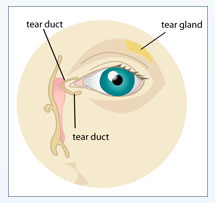Being bothered by “Dry Eyes” is one the most common problems that I treat in my ophthalmology practice. Luckily, when managed systematically and proactively, these symptoms should be very treatable and temporary. Whether you have already had Laser Vision Correction or are considering it in the future, this article explains the simple steps for optimizing eye comfort and teaches the scientific rationale behind these tips.
 Summary of the Problem
Summary of the Problem
Symptoms of “Dry Eyes” include foreign body sensation, burning sensation, fluctuating vision clarity, and light sensitivity. Any corneal surgery has the potential to affect corneal nerves and decrease tear production. A recent very large scientific review (based on 32,000 LASIK procedures from 46 independently published studies from 13 countries) evaluated the frequency, duration and cause of dry eyes after laser vision correction. The
study found that 35% of patients reported they noticed some dry eye symptoms after LASIK surgery, yet, 32% of patients also had these same symptoms PRIOR to surgery with glasses or contacts. Most patients reported returning to “normal or baseline” by 6 weeks after LASIK, but it can last for several months. Having dry eyes before LASIK was the best predictor of postoperative dry eye and severe dry eye problems were very rare. Also, thinner LASIK flaps, Intralase-based LASIK flaps, “nasal-hinged” LASIK flaps and Epi-LASIK/PRK have been associated with less dry eye symptoms. With scientific advancements and a better understanding of the ocular surface, various treatments have limited the severity of this problem.
If you have ever scratched your cornea or had a corneal infection, you already know that the corneal surface is very sensitive to touch or injury. A vast network of sensory nerves provides this sensitivity. In LASIK, creation of the corneal flap decreases the function of these nerves, which temporarily diminishes corneal sensitivity. Subsequently, the eye cannot effectively send nerve impulses to the tear gland for additional moisture. After these nerves grow back and normalize, sensitivity usually returns to normal levels within a couple months after treatment.
The corneal nerves enter the cornea along the horizontal axis at the 3 o’clock and 9 o’clock position. Older microkeratomes instruments used to make the LASIK flap hinge on the top (superior-based hinge), so both branches of these nerves were affected. Modern All-Laser LASIK have evolved to create a nasal-based hinge, which preserves the entire nasal branch of the corneal nerve and reduces the number of corneal nerves affected by the flap creation. LASIK flaps with a nasal-based hinge have shown to have a lower incidence of dry eye related problems. Until normal tear function returns, Dry eye can be the source of sub-optimal vision, fluctuating vision and eye discomfort until it resolves.
The normal human tear film is about 98% water, 1% oil and 1% mucous. These three components work together to hydrate the cornea, stabilize the tear film and prevent evaporation. The lacrimal gland and other ocular surface glands create all three essential parts of the human tear film. If any of these components are missing or out of proportion, the surface of the eye will “dry out”. When the ocular surface senses irritation, it sends a nerve impulse for the tear glands to produce tears (reflex tears). Other ocular surface glands consistently produce baseline tears are less dependent on nerve impulses (basal tears). In the postoperative period, simple measures can be taken to keep the cornea hydrated, stabilize the tear film and prevent tear evaporation.
With any corneal surgery, the ability to efficiently produce tears is temporarily affected. For this reason, it is very important to use preservative-free artificial tear eye drops at least 4 times per day for the first month after LASIK (whether one feels dryness or not), and longer if desired to maintain comfort. If used in a diligent manner for the recommended interval, this single remedy is effective for the vast majority of patients in keeping “dry eye” symptoms to a minimum. If preservative-free tears are used, there is no hazard preservative-induced irritation from over-use. There are many brands of preservative-free artificial tears available at the pharmacy or grocery store (i.e. Systane, Blink, Optive, Refresh Plus, Thera-Tears, and GenTeal). Some over-the-counter lubrication drops that come in a large bottle contain a “preservative”. Eye drop preservatives, such as benzalkonium chloride (BAK), tend to accumulate in the tear film and irritate the ocular surface. “Disappearing Preservative” artificial tears are expensive, but are safe to use if desired. Artificial tears WITH a
preservative should be avoided right after surgery and are better tolerated when only used once or twice per day.
606 Saratoga Ave,
San Jose, CA 95129
5790 Stoneridge Mall Rd, Pleasanton, CA 94588